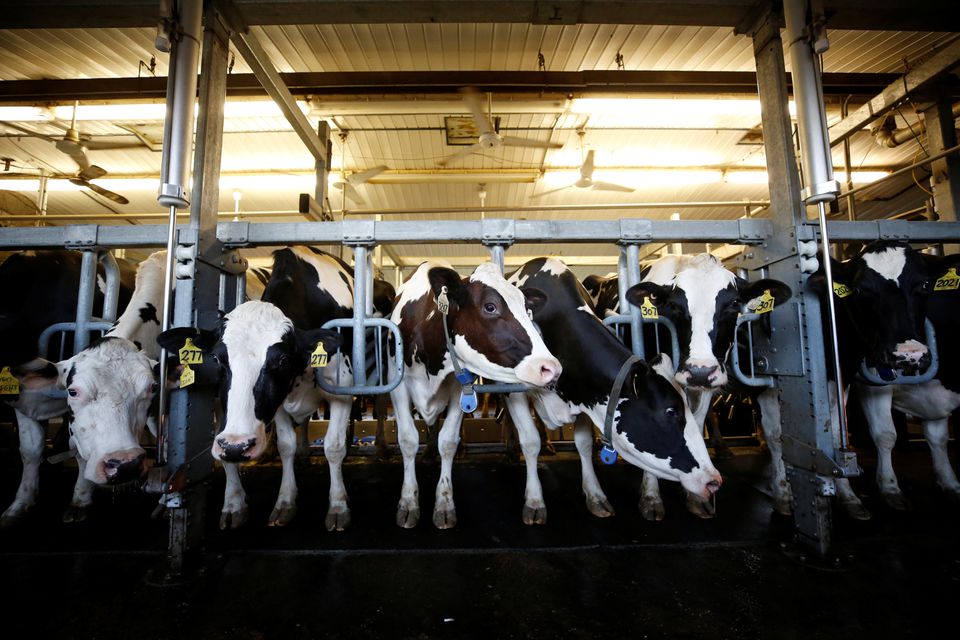Farmers defend milk price increase as commission reports a decline in production costs

Dairy commission says production costs have gone down, but farmers say that’s not the full picture because consumers won’t notice an increase in milk prices until dairy farmers begin to be paid more for their product a month from now
by Katie Hartai – CBC News
“We have no choice,” said Wietze Dykstra, the chair of Dairy Farmers of New Brunswick.
Dykstra milks about 200 cows in Knowlesville and said his production costs have gone up significantly over the past two years. He said a farm-gate milk price increase is essential to the survival of Canadian dairy.
“What would be a $50,000 bill last year would be a $100,000 bill this year,” he said. “We need a price increase to offset those costs.”
On Sept. 1, the price that farmers get for their milk will increase by 2.5 per cent. This comes after an 8.4 per cent increase in February. What that will translate into at the retail level is unknown.
The Canadian Dairy Commission is the federal body that oversees the country’s supply management system. It typically adjusts the farm-gate price of milk each February, but in June, Dairy Farmers of Canada requested the commission consider a mid-year hike.
“If you look at how they surveyed dairy farmers, from 2019 to 2020 the cost to produce milk went up two per cent, and that’s what they used to justify the increase of 8.4 per cent and now 2.5 per cent”
A double increase only happens under exceptional circumstances, according to Dykstra.
“It is unusual but not unheard of,” he said. “We do have a mechanism in place that if it is warranted we can ask the CDC.”
Wietze Dykstra is the chair of Dairy Farmers of New Brunswick. (Submitted by Wietze Dykstra)
Despite the double increase, data leaked from the Canadian Dairy Commission suggests some production costs went down in 2021. In an email to CBC, commission spokesperson Shana Allen confirmed the standardized cost of production for milk went from $85.42 to $84.57 per hectolitre.
But she explained that the commission bases its adjustment decisions on data from two years before. This means increases we are seeing now are based on the 2020 assessment, and the 2021 report will contribute to milk price adjustments in 2023.
According to Allen, the leaked numbers are preliminary and don’t include the Consumer Price Index, which she said is an important part of the final results.
Sylvain Charlebois, a professor of food distribution and food policy at Dalhousie University in Halifax, questioned the commission’s logic behind this year’s double increase.
“If you look at how they surveyed dairy farmers, from 2019 to 2020 the cost to produce milk went up two per cent, and that’s what they used to justify the increase of 8.4 per cent and now 2.5 per cent,” he said. “So a two per cent increase in cost and we got an 8.4 per cent?”
Since February, Canadians have seen fluid milk increase by about 25 per cent, according to Charlebois. He wants the dairy commission to be more transparent and release regular data on costing.
“The problem is when you look at the CDC and Dairy Farmers of Canada, both are one,” he said. “They talk to each other to set prices and completely push away processors, restaurant operators and consumers.”
Charlebois said without question farmers are paying more for some inputs now, but that should be reflected in the future.
Sylvain Charlebois is the Director of the Agri-Food Analytics Lab at Dalhousie University in Halifax. (Submitted by Sylvain Charlebois)
According to Dykstra, labour savings because of robotic milking is one of the main contributing factors to the decrease in production costs. He said otherwise, farmers are paying more for essentials like feed, fuel, and fertilizer.
“We have seen increases in fertilizer prices of almost 100 per cent,” he said. “The main reason is availability because of what’s going on overseas in Russia and Ukraine.”
He said these increases have been incredibly hard on cash flow and will prevent secondary work from happening around the farm.
“Because my fixed costs are up so much, basically any other projects like maybe improving some buildings, we just don’t have the money for this year,” he said.
Dykstra said producers wonder why the dairy industry needs to announce price changes when it’s not expected of other farm types that operate under supply management.
The most recent agricultural census by Statistics Canada states there are 162 dairy farms in New Brunswick. It reports that dairy farms have the second highest revenue of all farm types in the province as well as the second highest operating costs.














